by Claudio Morelli and Giorgio Busetto
(click on photos to enlarge image)
PAPAL STATES (ROME) SILVER HALLMARKS
FROM THE FRENCH DOMINATION (1809) TO THE KINGDOM OF ITALY
(1870)
The first statutes of the guild of Roman
goldsmiths date back to 1358, in which was stated
the rule of the warranty punch.
The University of Goldsmiths was founded in 1508 and
the statutes approved the following year introduced
the use of the master's mark in addition to the
previous guarantee mark.
In 1738, with the reform of the Statutes of
Goldsmiths, the guild acquired the name of "Nobil
Collegio degli Orefici ed Argentieri di Roma"
(Noble College of Goldsmiths and silversmiths of
Rome).
The warranty mark used prior to the French invasion
was a series of "crossed keys of St. Peter under
a liturgical umbrella" enclosed into shields,
ovals or other geometric shapes.
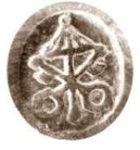




|
 |
THE ROMAN STATE UNDER THE FRENCH DOMINATION (1809-1815)
Napoleon Bonaparte, by decree dated May 17, 1809, attached
to the French Empire the territories belonging to the Papal
State.
Rome was declared "Imperial and Free City" including the town of
Rome, its surroundings and the Departments of Viterbo, Velletri,
Frosinone, Tivoli, Rieti, Spoleto, Perugia, Assisi and Todi ("Prima
Ricupera", see below).
With imperial decree dated April 13, 1810 was introduced in the
Roman territories the French model of hallmarking the precious
metal.
The measuring system of silver in use in Rome, based on the
ounces, was replaced by the decimal system and the title of the
silver fineness was given in thousands.
Were established two Assay Offices: Rome for the Department of
the Tiber (identified with the letter "H") and Spoleto for the
Department of Trasimeno (letter "I").
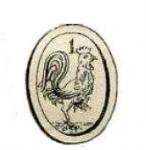 |
 |
950/1000 silver fineness
|
800/1000 silver fineness
|
 |
 |
 |
warranty mark
Rome, large works
|
warranty mark
Rome medium works
|
warranty mark
small works
|
 |
 |
warranty mark
Spoleto large works
|
warranty mark
Spoleto medium works
|
 |
 |
 |
 |
 |
reconnaissance
large works
|
reconnaissance
medium works
|
reconnaissance
small works
|
foreign silver
large works
|
foreign silver
small works
|
THE RESTORATION OF THE PAPAL STATES (1815-1870)
After the fall of Napoleon, the Congress of Vienna restored
the Pope in his territories and, on 24 May 1814, Pope Pius VII
returned to Rome.
Provisional marks were adopted for silver items under working
process at the time of the Papal Restoration.

|

|
provisional mark
(warranty)
|
provisional mark
(reconnaissance)
|
ROME
On January 7, 1815 was published the "Bando Generale
sulla garanzia delle manifatture d'oro ed argento" (General
rules about the warranty of silver and gold artefacts).
Rome and Departments were restored to the previous system based
on ounces and new hallmarks were established to replace those
adopted during the French Administration.
The new rules admitted three levels of silver fineness:
11,09 ounces ((947/1000), 10.16 ounces (889/1000) and 9.14
ounces (800/1000, only for old works)
Was also introduced a maker's mark of diamond (lozenge) shape
containing the initials of the silversmith and a number
attributed by the Rome Assay Office.
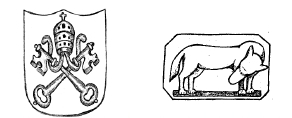 |
 |
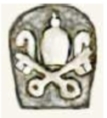 |
 |
1st title: 947/1000
|
2nd title: 889/1000
medium works
|
2nd title: 889/1000
small works
|
3rd title: 800/1000
old works
|
 |
Maker's mark Filippo
Pacetti c. 1830
|
SURROUNDING PROVINCES ("PRIMA RICUPERA")
The Provinces of the "Prima Ricupera" adopted similar
warranty marks, adding the silversmith's initials (left and
right side), the code of the town of his workshop (top) and that
of the Assay Office (bottom).
The town codes of the Assay Offices were: Frosinone uppercase
letter "C", Perugia lowercase letter "p", Spoleto uppercase
letter "S", Urbino uppercase letter "U", Viterbo uppercase
letter "V".
REMAINING PROVINCES ("SECONDA RICUPERA")
The edict published on July 25, 1817 organised the Assay
Offices of the territories annexed by Napoleon to the Kingdom of
Italy.
The offices in the territories of Bologna, Ferrara, Forlì,
Ravenna, Marche and Camerino (called "Seconda Recupera")
adopted similar marks with the following town codes:
Bologna uppercase letter "B", per Ferrara uppercase letter "F
(reversed)", Foligno uppercase letter "F", Forlì lowercase
letter "f", Ravenna uppercase letter "R" Macerata (for Marche
and Camerino) uppercase letter "M", Jesi uppercase letter "I".
With the same edict were attributed the town codes to other
Assay Offices:
Frosinone uppercase letter "C", Perugia uppercase letter "P",
Spoleto uppercase letter "S", Urbino uppercase letter "U" and
Viterbo uppercase letter "V".
 |
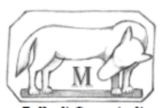 |
 |
 |
 |
warranty: large
works Ravenna
|
warranty: Macerata
|
warranty: medium
works Bologna
|
reconnaissance:
Forlì
|
old works: Ferrara
|
In 1860 the territories of the "Seconda Ricupera"
were annexed to the unified Kingdom of Italy. The Decree of
August 22, 1863 extended to these territories the Italian
hallmarking system with the addition of the initial of capital
town of the province.
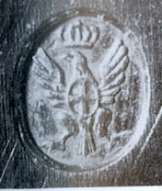 |
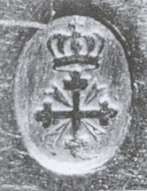 |
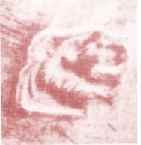 |
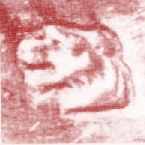 |
silver fineness
950/1000 large works
|
silver fineness
800/1000 large works
|
silver fineness 950/1000
small works
|
silver fineness 800/1000
small works
|
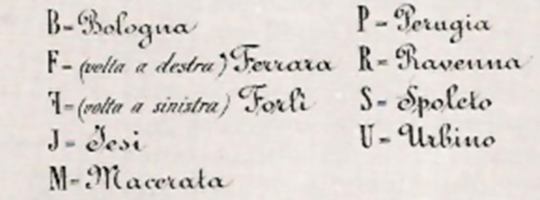 |
Initials of the capital
town of the provinces
|
In 1870, following the invasion of Rome by the Italian
troops, the Papal State ceased to exist.
After the conquest of Rome Italy attained its unity and a unique
system of hallmarking was introduced in the Regno d'Italia
(Kingdom of Italy).
The law 2 May 1872 deregulated silver production and introduced
only a not compulsory inspection of silver artifacts.
 |
 |
 |
silver fineness
950/1000
optional hallmark
|
silver fineness
900/1000
optional hallmark
|
silver fineness
800/1000
optional hallmark
|
PAPAL STATES IN THE 19TH CENTURY: BRIEF HISTORICAL
CRONOLOGY
In 1799 the Papal States as a whole were invaded by French
forces, who declared a Roman Republic. Pope Pius VI died in
exile in Valence (France) in 1799. The Papal States were
restored in June 1800 and Pope Pius VII returned, but the French
again invaded in 1808, and this time the remainder of the States
of the Church was annexed to France, forming the départements of
Tibre and Trasimène.
With the fall of the Napoleonic system in 1814, the Papal States
were restored once more.
In 1860, with much of the region already in rebellion against
Papal rule, Sardinia-Piedmont conquered the eastern two-thirds
of the Papal States. Bologna, Ferrara, Umbria, the Marches,
Benevento and Pontecorvo were all formally annexed by November
of the same year, and a unified Kingdom of Italy was declared.
The Papal States were reduced to Latium, the immediate
neighborhood of Rome.
On September 10, 1870, Italy declared war on the Papal States
and the Italian Army crossed the frontier of the then remaining
papal territory on September 11 advancing towards Rome. The city
was captured on September 20, 1870. Rome and Latium were annexed
to the Kingdom of Italy as a result of a plebiscite the
following October and the Papal State ceased to exist.
(based on information by Wikipedia.org)
Claudio Morelli and Giorgio Busetto
- 2013 -
|
|
|

